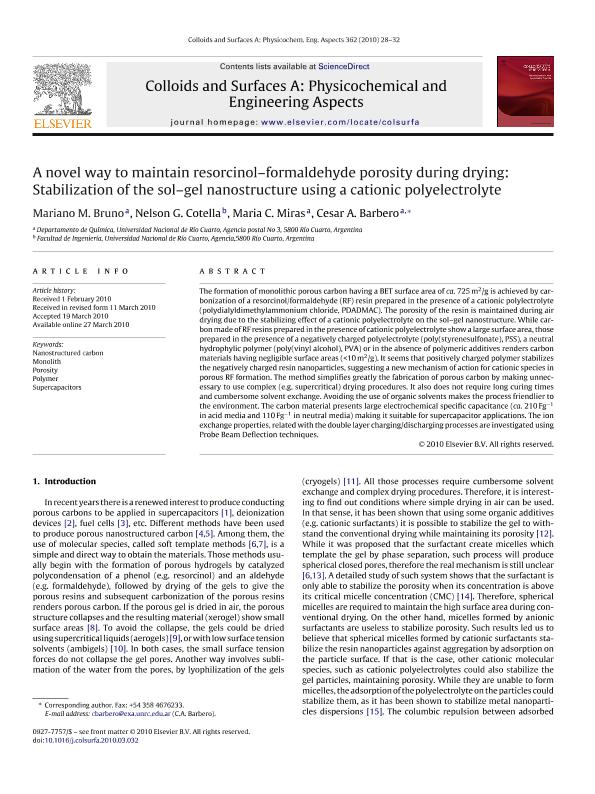Artículo
A novel way to maintain resorcinol-formaldehyde porosity during drying: Stabilization of the sol-gel nanostructure using a cationic polyelectrolyte
Fecha de publicación:
06/2010
Editorial:
Elsevier Science
Revista:
Colloids and Surfaces A: Physicochemical and Engineering Aspects
ISSN:
0927-7757
Idioma:
Inglés
Tipo de recurso:
Artículo publicado
Clasificación temática:
Resumen
The formation of monolithic porous carbon having a BET surface area of ca. 725m2/g is achieved by carbonization of a resorcinol/formaldehyde (RF) resin prepared in the presence of a cationic polylectrolyte (polydialyldimethylammonium chloride, PDADMAC). The porosity of the resin is maintained during air drying due to the stabilizing effect of a cationic polyelectrolyte on the sol-gel nanostructure. While carbon made of RF resins prepared in the presence of cationic polyelectrolyte show a large surface area, those prepared in the presence of a negatively charged polyelectrolyte (poly(styrenesulfonate), PSS), a neutral hydrophylic polymer (poly(vinyl alcohol), PVA) or in the absence of polymeric additives renders carbon materials having negligible surface areas (<10m2/g). It seems that positively charged polymer stabilizes the negatively charged resin nanoparticles, suggesting a new mechanism of action for cationic species in porous RF formation. The method simplifies greatly the fabrication of porous carbon by making unnecessary to use complex (e.g. supercritical) drying procedures. It also does not require long curing times and cumbersome solvent exchange. Avoiding the use of organic solvents makes the process friendlier to the environment. The carbon material presents large electrochemical specific capacitance (ca. 210Fg-1 in acid media and 110Fg-1 in neutral media) making it suitable for supercapacitor applications. The ion exchange properties, related with the double layer charging/discharging processes are investigated using Probe Beam Deflection techniques.
Palabras clave:
MONOLITH
,
NANOSTRUCTURED CARBON
,
POLYMER
,
POROSITY
,
SUPERCAPACITORS
Archivos asociados
Licencia
Identificadores
Colecciones
Articulos(CCT - CORDOBA)
Articulos de CTRO.CIENTIFICO TECNOL.CONICET - CORDOBA
Articulos de CTRO.CIENTIFICO TECNOL.CONICET - CORDOBA
Citación
Bruno, Mariano Martín; Cotella, Nelson Gustavo; Miras, Maria Cristina; Barbero, César Alfredo; A novel way to maintain resorcinol-formaldehyde porosity during drying: Stabilization of the sol-gel nanostructure using a cationic polyelectrolyte; Elsevier Science; Colloids and Surfaces A: Physicochemical and Engineering Aspects; 362; 1-3; 6-2010; 28-32
Compartir
Altmétricas




